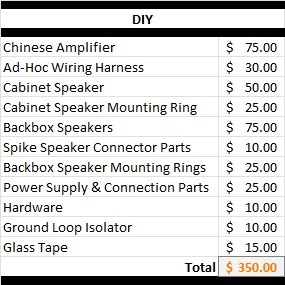PinWoofer - Pinball DIY Sound and Audio
Posted by PinWoofer on Sep 16th 2021
Make the right choice.
Integration:
Do-It-Youself'er's face challenges selecting the right gear, creating connectors and wiring harnesses and the all-important selection of a clean power solution that runs at a safe voltage. Even if you do everything "right", it is possible to end up with a noisy system due to the array of audio issues that may present themselves when using unmatched parts but are avoided by the integration PinWoofer offers. There are a number of other form/fit/function pitfalls if you don't have a well measured plan and the required knowledge up front.
Performance:
Making the right choice for power, amplifier and speakers is vital. When doing a DIY, you may think you've got the best system possible because you have not heard a direct comparison, but this is almost never true compared against the PinWoofer system (we've tried many combinations and always come to the same conclusion):
Power: Many low-cost Chinese amplifiers employ an AC to DC wall converter which has a virtual ground (as opposed to an earth ground in the machine). This often gives rise to an audible and unresolvable ground loop. This power supply also lacks the bypass capacitance necessary to produce strong bass hits and sustain. It is also difficult to wire the supply to turn on and off with the machine.
Amplifier: These amplifiers almost always lack the proper use of ground planes, tie-downs, polygons and ferrite beads (for noise immunity). Chinese products are generally a knock-off of a superior American designed product and little or no knowledge of "tricks of the trade" are applied to the design. This results in low performance compared to the American designed PinWoofer amplifier.
Speakers: while automotive / marine speakers can be made to fit into a pinball machine, they are not the best choice because of the materials used, the fact that they directly face the listener or their sensitivity. PinWoofer backbox speakers employ a larger than standard textile dome tweeter and a highly sensitive 2Ohm, dual voice-coil speaker which is able to extract the maximum amount of power from the class D amplifier. The sound quality of our speakers is hard to match.
Tech Support:
PinWoofer offers technical support with our super kit, with phone and email support during the day on weekdays. Most have no issues, but if you do, it is reassuring to know PinWoofer has your back! Ask yourself if Amazon or Ali Express can make this claim!
Cost:
Below is a spending analysis showing a DIY cost breakdown. Pure DIY costs consider required components to match the PinWoofer system in terms of functionality, but with a less impressive outcome. The required time sink will be about 4-8 hours taking the DIY route (maybe days if things go south), compared to less than one hour when choosing PinWoofer out of the gate. The cost is about the same as going with a PinWoofer kit and you'll thank yourself for doing so considering the brand recognition of PinWoofer and potential to ask more upon resale of your title, compared to kludging your own DIY setup:

Risk:
We're seeing a large number of new folks in the hobby, and many may be unfamiliar with the risk of working around their electronics. We have concerns over the potential to wire up in a way that does damage to your CPU node / amplifier board. We've also had many calls from guys who have made mistakes or made "creative" decisions and have ended up with some pretty significant damage to their CPU ($500-$800 repair / replacement cost). Some of the cheap components out there are of low quality and more importantly, lack sufficient testing and screening to ensure that you don't put your electronics in jeopardy. (Customer scare photos below.)

Conclusion:
For most, the DIY route falls short of unlocking the potential of your title. If you are not confident in your ability to put everything together, or simply don't want to waste your time chasing an audio upgrade for about the same cost as a fully integrated PinWoofer system, go with PinWoofer.
In DIY, you'll be spending a significant amount of time chasing between at most $50 in savings compared to the tried-and-true system PinWoofer offers and it won't sound as good. Ask yourself if it's worth it!
